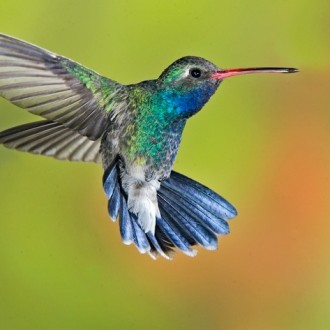


How to Draw a Hummingbird
Please PAUSE the video after each step to draw at your own pace (scroll down to see the final hummingbird drawing).
For the first few steps, don’t press down too hard with your pencil. Use light, smooth strokes to begin.
Step 1: Draw an oval as a guide for the hummingbird’s body. Don’t worry if the oval isn’t perfect. It’s just a guide.
Step 2: Draw a circle on the top right side of the oval as a guide for the hummingbird’s head.
Step 3: Draw two intersecting lines inside the head to help you place the hummingbird’s facial features later on.
Step 4: On the right side of the head, draw a straight line as a guide for the hummingbird’s beak.
Step 5: On the upper left side of the body, draw a long arc as a guide for thehummingbird’s wing. The size of the arc will determine the size of the wing, so don’t draw it too long or too thick.
Step 6: Draw a smaller, shorter arc on the lower left side as a guide for the rest of the hummingbird’s torso.
Step 7: Draw a couple of lines that connect the main oval to the head to form the neck. Draw a line on the lower part of the body as a guide for the tail.
That’s it for the initial sketch! From this point on, press harder with your pencil to get a more defined sketch.
Step 8: Draw the hummingbird’s eye inside the head. Use the intersecting lines as guides for placement. The shape of the eye is similar to an oval with pointed ends. Shade it in except for a small circle to represent glare. Draw a few lines surrounding the hummingbird’s eye for extra detail.
Step 9: Use the line as a guide to draw the hummingbird’s beak. Darken the line and then draw another line above that one for the top portion of the beak. Draw yet another line below those for the bottom part of the hummingbird’s beak. Also draw a few quick, short strokes to represent feathers at the base of the beak.
Step 10: Use the initial circle as a guide to draw the rest of the hummingbird’s head. Use quick, short strokes to represent feathers near the back of the head.
Step 11: Use the arc as a guide to draw the wings. Make the wing more pointy at the end. Use tiny arcs or bumps as you follow the guide for the lower part of the wing. Use a few lines on the top side to form the base of the wing. Use a series of diagonal lines inside the wing to represent hummingbird feathers. Use a similar shape to draw the other wing. Because it’s on the other side, you don’t have to add detail.
Step 12: Draw the feet on the bottom part of the body near the main oval. The feet are tucked within the hummingbird’s feathers, so just draw a few quick, short strokes to represent this and some curved lines for the actual toes.
Step 13: Darken the outer lines to form the body.
Step 14: Use the line at the bottom to draw the hummingbird’s tail. Use long, narrow arcs that connect to the hummingbird’s body for the tail feathers.
Step 15 (optional): You can stop here for a sketchy look or erase as much as you can of the initial guide lines for a cleaner look. Don’t worry about erasing all of them. It’s okay to leave some behind. Also re-draw any final sketch lines that you may have accidentally erased.
Step 16 (optional): Add some shading to your hummingbird drawing to give it more dimension and volume. Pick the direction of the light source when shading so that the shadows are consistent with it. Vary the pressure on your pencil to get different degrees of tonal value.
Step 17 (optional): You can add more value throughout your hummingbird drawing for extra detail. It’s a good idea to use reference to be as accurate as possible in depicting the specific species of hummingbird you want to draw. If you want to draw a ruby-throated hummingbird like this one, remember to PAUSE the video whenever you need help. You can add color to your drawing too!


